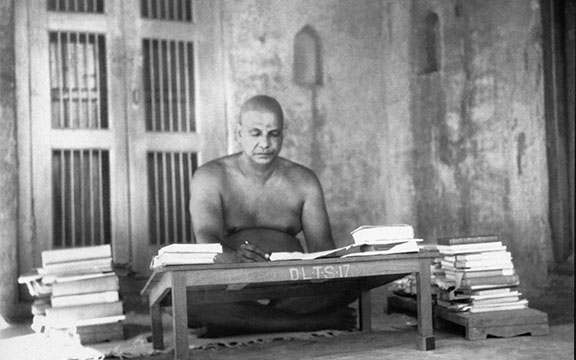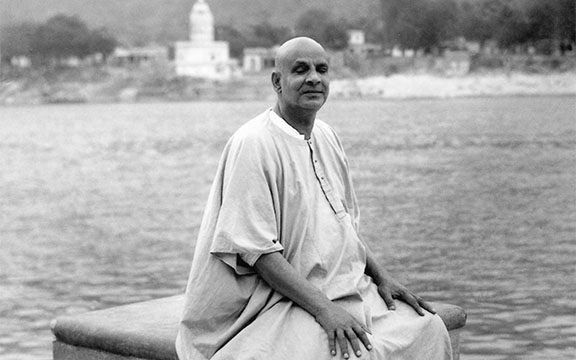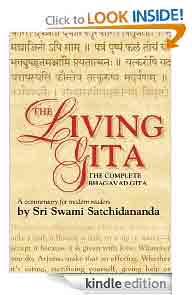
Photo: Sri Swami Sivananda was prolific in writing books on Yoga; 1950s.
The Fourfold Sadhana of Jnana Yoga consists of viveka, vairagya, shadshampat or sixfold virtues and mumukshutva or strong yearning for liberation. Viveka dawns in one who, through the grace of God, has done virtuous actions in their previous births as offerings unto God without expectation of fruits and without egoism. Viveka is the discrimination between the real and the unreal, the permanent and the non-permanent, Atman and Anatma.
You must first develop Viveka or discrimination between the real and the unreal and Vairagya or dispassion for the enjoyment of objects herein and hereafter. Then only you will have success in the practice of sama. Vairagya born of viveka only will be of a lasting nature.
Sama is serenity of mind produced by the constant eradication of vasanas or desires. Whenever desires crop up in your mind do not try to fulfill them. Reject them through discrimination, right inquiry and dispassion. You will get tranquility of mind and mental strength by constant practice. The mind is thinned out. The mind is checked directly from wandering; its out-going tendencies are curbed. The mind is detached from the manifold sense objects by continually observing their defects and is fixed on Brahman. In the practice of sama, the five jnana-indriyas or organs of knowledge, viz., ear, skin, eye, tongue and nose are also controlled.
Dama is the control of the external organs, i.e., the organs of action or the five karma-indriyas, viz., organ of speech, hands, feet, genitals and the anus and the external instruments, the organs are withdrawn and fixed in their respective centres.
The eyes run outside to see a beautiful object. If you at once withdraw the eyes from that object, it is called dama. You should restrain the other Indriyas also by the practice of dama. Some say, practice of dama is not necessary. It is included in sama. The indriyas cannot work independently. They can work only in conjunction with the mind. If the mind is checked, the indriyas will come under control automatically.
The mind will come under control very easily if dama also is practised. It is a double attack on the enemy from within and without. One is crushed or subdued soon. If the front and back doors are closed simultaneously, the enemy is caught quite readily. There is no escape for them on any side.
By practice of dama you do not allow either the indriyas or the mind to come in contact with the objects. You do not allow the mind to come through the external instrument, viz., the eye, to assume the form of the object. In neophytes the mind never remains self-centred despite rigorous practice of sama. It tries to run outside towards external objects. If dama is also practised, it will be of immense help to curb the mind efficiently. If you tie the hands of a mischievous boy, he tries to do mischief with the feet. If his feet, also are tied he keeps quiet. Sama corresponds to the tying of the hands and dama to the tying of the feet. Therefore the practice of dama is also necessary.
Dama is a practice of a student of Jnana Yoga. Pratyahara corresponds to the practice of dama. Pratyahara is the practice of a Raja Yogi. In the former it follows the practice of sama; in the latter it follows the practice of pranayama. In the former the indriyas are withdrawn by calming or restraining the mind; in the latter the indriyas are withdrawn by restraining the prana. The Indriyas can be withdrawn more effectively by the process of double withdrawal, by withdrawing the mind and the prana at the same time. It is the mind that moves the indriyas. It is the prana that vivifies or energises or galvanises the indriyas. Sama and dama are strictly speaking Raja Yogic practices.
Now we come to the practice of uparati. Some define uparati as renunciation of all works and taking up Sannyasa. Uparati follows the practice of sama and dama. Uparati is self-withdrawal. It consists in the mind-function ceasing to act by means of external objects. Uparati is extreme abstention. It is the turning of the mind from the objects of enjoyment.
The mind of the student who is established in uparati will never be agitated even a bit when they see a beautiful object. There will be no attraction. When they look at delicious fruits or palatable dishes, they will not be tempted. They will have no craving for any particular object or dish. They will be satisfied with anything that is placed before them. This is due to the strength of mind he has developed by the practice of viveka, vairagya, sama and dama.
Further the mind is experiencing a wonderful calmness and transcendental spiritual bliss by the above practices. It does not want these little, illusory pleasures. You can wean the mind from the object to which it is attached by training it to taste a superior kind of bliss. If you give cotton-seed extract to a bull or a cow, it will not run towards dry grass or hay. Mind is like the bull.
Those who practise brahmacharya must be fully conversant with the technique of sama, dama and uparati. Then only they will be established in the practice of celibacy.

Photo: Sri Swami Sivananda meditating on the banks of the Ganges.
Titiksha is the power of endurance. A titikshu is able to bear pain, insult, heat and cold. They do not care to redress them. They are free from anxiety.
Sraddha is unshakable faith in the existence of Brahman, in the teachings of Guru and scriptures, and faith in one’s own Self. If anyone possesses these qualifications they will get samadhana or one-pointedness of mind and burning desire for liberation. The mind will move naturally towards the inner Self always. The student should now approach a Brahma-Srotri, Brahmanishtha Guru, hear the Srutis, reflect and meditate on the significance of the Tat Tvam Asi Mahavakya constantly. They will attain Self-realisation or Atma-Sakshatkara.
If you have viveka, vairagya will come by itself. If you possess viveka and vairagya, sama will dawn by itself. If you are endowed with viveka, vairagya and sama, dama will come by itself. If you have sama and dama, uparati will come by itself. If you have all these qualifications, titiksha, sraddha and samadhana or one-pointedness will come by themselves. If you possess viveka, vairagya, sama, dama, uparati, sraddha and samadhana, mumukshutva or burning desire for liberation will manifest by itself.
Even in a Jivanmukta or a liberated sage the eyes will move towards the objects through the force of habit. But they can withdraw them completely and make them mere empty sockets if they will. They see the whole world within themselves. There are no evil thoughts in their mind. This is the difference between the vision of a Jnani and a worldly person.
Some students ask: “Shall we practise viveka, vairagya, etc., in order, one by one, after mastering each anga or shall we practise all the angas simultaneously? If we practise one by one, perhaps we will not be able to get mastery over one or two angas in this life. We may require several births for perfect mastery over all angas. Life is very short. What shall we do?” It depends upon the temperament, taste and capacity of the students. Some like to get perfect mastery over each stage and then proceed to the next step. Some like to practise all the limbs at the same time. For six months concentrate your mind in cultivating viveka, vairagya and sama. For the next six months try to acquire sraddha, samadhana and mumukshutva. Devote more time in developing that virtue which you are seriously lacking. If you are earnest and sincere in your attempt, you can develop the four means and attain Self-realisation in this very birth.
Another Vedantic student says, “Swamiji, there is no necessity for acquiring these four means of salvation, viveka, vairagya, etc. It is a long, tedious process. I will not be able to acquire them even in several births. The shortest way is to think of Brahman always. I will acquire all the virtues automatically. Then I will be able to practise deep meditation.” He is right. A first class type of student can adopt this method because he had cultivated the four means in his previous births. A mediocre student will not be able to think of Brahman at the very outset. How can one think of Brahman when the mind is filled with impurities, when the mind is turbulent and the indriyas are jumping and revolting? Absolutely impossible. He may sit for thinking on the Self. He will be building castles in the air and will be thinking of other objects. He will foolishly imagine that he entered into Nirvikalpa Samadhi. He will mistake deep sleep for Samadhi. Many are deluded in this manner. They do not have any spiritual progress. They can have no idea of Brahman. It is only the mind that is rendered pure by the practice of viveka, vairagya, sama, dama, etc., that can have definite conception of Brahman. Ideas of Brahman cannot be lodged in a restless, impure mind.
May you all live drowned in the ocean of Brahmic Bliss in an illumined state through the practice of viveka, vairagya, sama, dama, uparati, titiksha, sraddha and samadhana!
~Excerpted from Fourfold Sadhana by Sri Swami Sivananda


